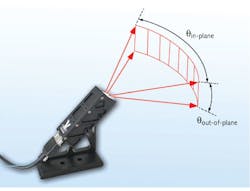
Recognizing that electro-optical beam scanners/deflectors based on diffractive techniques are limited to small angles because grating efficiency drops as scan angle increases, engineers at Vescent Photonics (Golden, CO) have developed a liquid crystal (LC) waveguide approach that scans a 30° × 5° field of view with low power consumption at a frame rate of less than 50 ms/frame.
The scannable electro-evanescent optical refractor (SEEOR) uses LCs that possess an electro-optic response more than 105 times larger than lithium niobate as a cladding layer in a LC-waveguide architecture, whereby the evanescent field of the guided wave extends into an adjustable-refractive-index LC cladding. Rather than transmitting the beam directly through a thin LC layer, the evanescent approach decouples the interaction length from the thickness of the LC layer, creating a well-ordered LC-surface region that provides low insertion losses (as little as 3 dB) and fast response times (in the range of 10 to 500 μs). Circumventing the historic LC limitations of a short interaction length and slow relaxation times, the truly continuous analog scanner does not suffer from 2π reset gaps and is housed in a compact package measuring less than 3.5 in3. In lab experiments, devices that scan as much as 270º in a single plane have been demonstrated. Reference: www.vescent.com/wp-content/uploads/2015/04/LS3.2.pdf.

Gail Overton | Senior Editor (2004-2020)
Gail has more than 30 years of engineering, marketing, product management, and editorial experience in the photonics and optical communications industry. Before joining the staff at Laser Focus World in 2004, she held many product management and product marketing roles in the fiber-optics industry, most notably at Hughes (El Segundo, CA), GTE Labs (Waltham, MA), Corning (Corning, NY), Photon Kinetics (Beaverton, OR), and Newport Corporation (Irvine, CA). During her marketing career, Gail published articles in WDM Solutions and Sensors magazine and traveled internationally to conduct product and sales training. Gail received her BS degree in physics, with an emphasis in optics, from San Diego State University in San Diego, CA in May 1986.